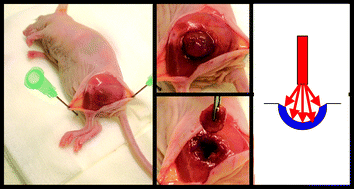Photochemical internalization as an adjunct to marginal surgery in a human sarcoma model
Abstract
Local recurrences after inadequate surgery are a major challenge in many cancers. Photochemical internalization (PCI) is a new technology to release endocytosed macromolecules into the cytosol by a photochemical rupture of the endocytic vesicles. A recent study on an invasive human fibrosarcoma xenograft HT1080 indicated low sensitivity of the tumour periphery to disulfonated aluminium phthalocyanine (AlPcS2a)-based photochemical treatment. The main goal of the present study was to evaluate the sensitivity of the remaining tumour after marginal resection of the HT1080 tumour to the photochemical treatment alone and PCI of bleomycin. AlPcS2a and bleomycin was systemically administrated 48 h and 30 min, respectively, prior to surgery and immediately followed by intra-operative light exposure at 670 nm (15 J cm−2). PCI of bleomycin as an adjunct to surgery did significantly delay tumour growth in contrast to the photochemical treatment alone. The results indicate that PCI of bleomycin may be an efficient intra-operative technique to eradicate cancer cells in the wound bed after inadequate surgery.


 Please wait while we load your content...
Please wait while we load your content...